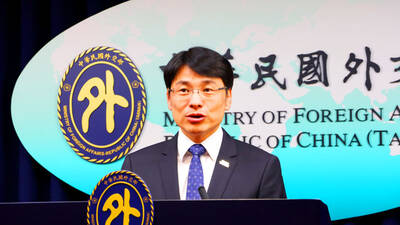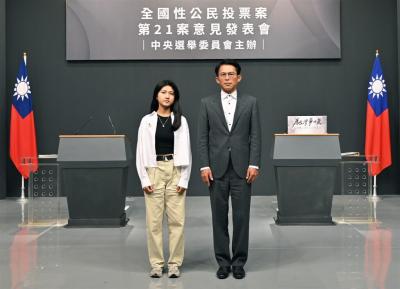A Taiwanese research team has reported a breakthrough in carbon dioxide (CO2) capture biotechnology which it hopes will contribute to the reduction of greenhouse gas emissions in an efficient and environmentally friendly way.
The research team, led by Chang Chuan-hsiung (張傳雄), an associate professor at National Yang Ming University’s Center for Systems and Synthetic Biology, said the new process developed by the team enhances the ability of microalgae to capture carbon dioxide by up to 50 percent.
“We’ve set the goal of doubling the efficiency of the CO2 capture by the end of this year and tripling it next year,” Chang said.
As concern over global warming has risen, scientists have studied different ways of capturing carbon dioxide emitted into the air and storing it.
Chang said carbon capture technologies generally fall into three main categories: chemical and physical processes (which concentrate CO2 through combustion under high pressure and temperature) and biological processes.
The first two processes, Chang said, are costly, mostly due to their high consumption of energy and the large volume of chemicals they require, and produce severe storage and leakage challenges.
The process developed by the university, on the other hand, not only reduces carbon dioxide emissions, but turns the carbon fixed in the process into biomass (such as carbohydrates) through photosynthesis.
The biomass can then be converted into biofuel or other high-value materials.
“It is an eco-friendly biotechnology that does not harm the environment and can re-utilize the captured CO2 through natural processes like photosynthesis,” he said.
Chang said other research teams have studied biological methods to capture CO2, but have faced obstacles because of relying on traditional metabolic engineering approaches rather than his team’s genome engineering process.
“Our team is the first to achieve such a high rate of CO2 capture efficiency using a biological approach,” Chang said.
He said that microalgae only absorb the carbon dioxide they need to survive, but his team has been able to enhance their carbon capture ability by 50 percent through genome analysis, design and engineering.
That was made possible in 2008 when his team developed a genome analysis platform that enabled scientists to get a complete picture of how genes of microorganisms function and are regulated.
In the process developed by Chang and his team, microalgae grow in water that has a high concentration of dissolved CO2, which then is transported into microalgae cells through controlled gene regulation.
Through photosynthesis, the CO2 and water absorbed by the algae is transformed into carbohydrates, which can then be converted into valuable products, such as small molecule drugs, chemical compounds and biofuels.
“This way, we help reduce greenhouse gas emissions and turn them into renewable biofuels,” said Chang, who published the results of the study in the August issue of Energy & Environmental Science, a leading journal in the field of energy research.
The new biotechnology has been applied in the factory of Chung Hwa Pulp Corp in Hualien since early this year, with the company’s gas emissions collected and then diverted to photobioreactors, where the microalgae consume the carbon dioxide.
At present, the scale of the approach’s carbon dioxide capture is limited, with an initial target of between 3,000 tons and 10,000 tonnes per year, because the process is still in the developmental stage.
Chang said the team needs to learn more about the different kinds of microalgae and gene manipulation needed to take on each specific job.
Microalgae that might be effective at the pulp plant, for example, might be less effective in digesting the carbon dioxide at a petrochemical plant because of the different mixtures of emissions produced.
The team is also studying a wide range of microalgae to see which absorb the most carbon dioxide to begin with.
It has already tested several freshwater and marine microalgae species and is now focusing on algae strains found in salt water and high-temperature water, such as hot springs.
More than 20 companies and research institutions at home and abroad have expressed keen interest in this new genome-based biotechnology and have contacted the team for possible licensing.

The Japan-Taiwan Exchange Association has cautioned Japanese travelers to be vigilant against pickpockets at several popular tourist spots in Taiwan, including Taipei’s night markets, the Yongkang Street area, Zhongshan MRT Station, and Jiufen (九份) in New Taipei City. The advisory, titled “Recent Development of Concerns,” was posted on the association’s Web site under its safety and emergency report section. It urges travelers to keep backpacks fully zipped and carried in front, with valuables placed at the bottom of the bag. Visitors are advised to be especially mindful of their belongings when taking photos or speaking on the phone, avoid storing wallets and

ENDORSING TAIWAN: Honduran presidential candidate Nasry Afura said that Honduras was ‘100 times better off’ when it was allied with Taipei The Ministry of Foreign Affairs yesterday said it would explore the possibility of restoring diplomatic relations with Honduras based on the principle of maintaining national interests and dignity. The ministry made the remarks in response to reporters’ questions regarding an article titled: “Will Taiwan Regain a Diplomatic Ally?” published in The Diplomat on Saturday. The article said Honduras’ presidential election in November could offer Taiwan the chance to regain an ally, as multiple candidates have promoted re-establishing diplomatic relations with Taiwan. Honduras severed diplomatic ties with Taiwan in March 2023 in favor of Beijing, but since switching its diplomatic recognition,

A fourth public debate was held today about restarting the recently decommissioned Ma-anshan Nuclear Power Plant, ahead of a referendum on the controversial issue to be held in less than two weeks. A referendum on Aug. 23 is to ask voters if they agree that “the Ma-anshan Nuclear Power Plant should continue operations upon approval by the competent authority and confirmation that there are no safety concerns.” Anyone over 18 years of age can vote in the referendum. The vote comes just three months after its final reactor shut down, officially making Taiwan nuclear-free. Taiwan People’s Party Chairman Huang Kuo-chang (黃國昌) represented

Scoot announced yesterday that starting in October, it would increase flights between Taipei and Japan’s Narita airport and Hokkaido, and between Singapore and Taipei. The low-cost airline, a subsidiary of Singapore Airlines, also said it would launch flights to Chiang Rai in Thailand, Okinawa and Tokyo’s Haneda airport between December and March next year. Flights between Singapore and Chiang Rai would begin on Jan. 1, with five flights per week operated by an Embraer E190-E2 aircraft, Scoot said. Flights between Singapore and Okinawa would begin on Dec. 15, with three flights per week operated by Airbus A320 aircraft, the airline said. Services between Singapore